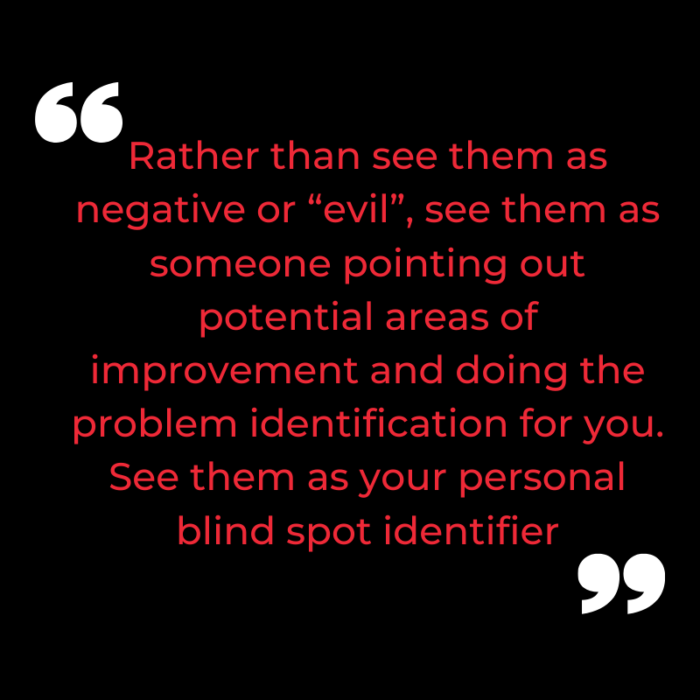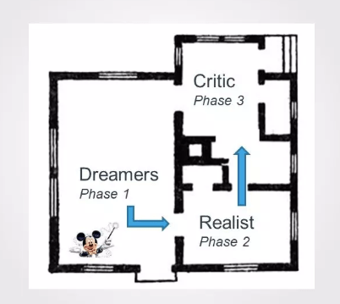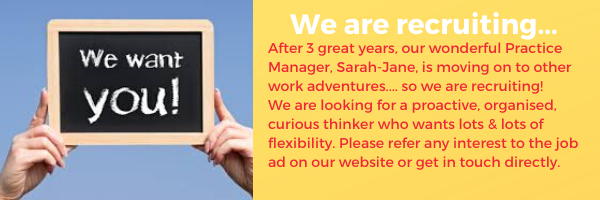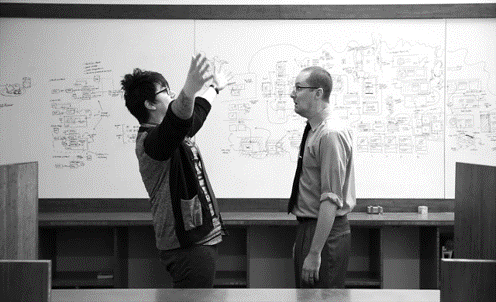 Eye roll as “colleague negative” rolls out their tried and tested criticism of any change or approach!!
Eye roll as “colleague negative” rolls out their tried and tested criticism of any change or approach!!
“It just won’t work because of…”
“Your approach is all wrong…”
“Last time we tried this, it failed…”
“You haven’t thought this through… How will this work practically?? (sarcastic voice)”
Ahhhhhhhh! It’s so frustrating and disheartening! What’s your general response? Do you argue? Do you dismiss them? Do you collect their comments so you can bitch about it with others once the meeting finishes? Do you disengage from the discussion and not share your views? None of these responses are productive!
What if you are missing an opportunity? What if that negative, critical colleague is a rough gem and has pearls of wisdom that could benefit you? What happens if you could change your thinking about this individual and embrace them because you see the value they can bring?
It feels awkward to want to hug or embrace something that is “negative”, but let’s go with it. Rather than see them as negative, or “evil”, see them as someone pointing out potential areas of improvement and doing the problem identification for you. See them as your personal blind spot identifier listing things you should be thinking about. To make their comments useful, and add some accountability to them, try asking them to list their insights. You can then explain how those issues identified can be solved, or even better, problem-solve them together.

Perhaps there are issues you hadn’t thought about. My advice is, keep them close. Hug them tightly. Often, they are bravely saying what others won’t, need to or haven’t even thought of yet.
Just to be clear I am advocating metaphorical hugging of colleagues in the workplace. Not actual, literal, physical, “golden retriever cuddles”. Just in case you need clarification on this topic here’s a quick article on why you shouldn’t hug your work colleagues and now we are hearing of “elbow bumps” and “foot shakes”.
Often those who we consider to be negative are just starting their thinking process with
“what could go wrong”. Others initially start with “this is good, let’s work out how to make it happen”. We are attracted to the optimism, yet both types of thinking are necessary and valid to make change, solve problems or bring about innovation. The problem is they seem at odds with each other even though ideally, they complement each other to help us arrive at the destination. They are both necessary and valid when resolving workplace tension.
One coaching tool I LOVE using, particularly with teams in conflict, is the Disney model. It is comparable to ‘De Bono’s Six Thinking Hats’. The Disney Creative Strategy was developed to improve a process or plan, increase creativity and fuel innovation. We use it in workplace conflict resolution – which as we’ve said before is just a fancy way of saying problem-solving. It takes people through a structured process where everyone has an opportunity to be:
- a dreamer and brainstorm ideas,
- a realist to bring pragmatism to the dream, and
- constructively, collectively critique the issues to identify weaknesses, obstacles or risks.

I love using it for conflict resolution as it allows those often branded negatively for raising problems to be seen as in a new constructive light. If you want to know a bit more about the Disney model, see HERE. Also, here’s a great article on the theme by HBR: Don’t Demonize Employees who Raise Problems. It talks to leaders about “celebrating the agitation” and challenges leaders to recognise and reward those who bring issues forward that need addressing.
 Here’s your challenge. Next time a “negative colleague” appears to get excited. Choose to join them in their space of problem identification. Brainstorm it out with them. You may just gain some insights that allow you to resolve issues. Keep me posted. I’d love to know how you go.
Here’s your challenge. Next time a “negative colleague” appears to get excited. Choose to join them in their space of problem identification. Brainstorm it out with them. You may just gain some insights that allow you to resolve issues. Keep me posted. I’d love to know how you go.
– – – – – – – – – – – – – – – – – – – – – – – – – – – – – – – – – – – – – – –




